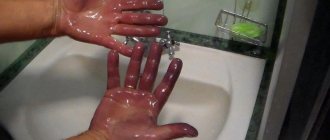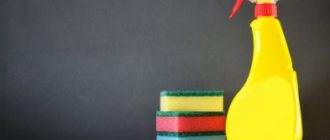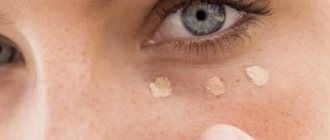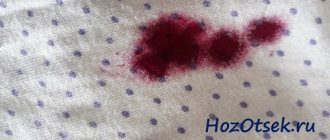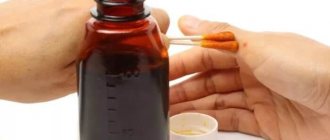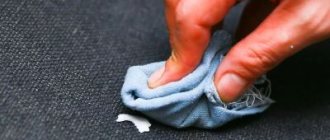A stationery proofreader is the most convenient thing among all the working tools of every person in the office. They can cover up all the shortcomings and mistakes that have been made. However, at the most inopportune moment, you can get dirty yourself. In fact, every person has encountered such a problem that his hand or clothes were smeared with putty. Removing such stains is not so easy. Today we will talk about how to remove concealer from skin, tables, clothes and other objects.
Features of stationery putty
Loading…
If you have stained yourself with caulking liquid and don’t know how to remove it, you shouldn’t think that this stain will remain on your things or the table for the entire time. There are several tips and ways to easily remove putty from skin or clothing.
At the initial stage, you need to determine what the main substance in the corrector is. It can be alcohol, emulsion, water or a dry base.
Important! Often, the composition is written on a jar of correction fluid and in English. If you do not speak a foreign language perfectly, arm yourself with a translator, and he will help you cope with this problem.
The composition of the sealing liquid determines how to solve the dilemma of how to wipe the putty off a table or other object.
Means and methods for removing putty from clothes
Taking into account the type of clothing material, you can clean the streak from things using the following means:
- plain cold water with the addition of detergent (regular soap, washing powder, dishwashing detergent, stain remover);
- special chemicals, for example, those produced, the use of which is carried out according to the instructions for the selected product;
- using laundry soap and Antipyatin soap for complex stains;
- Lemon juice, as a handy remedy, can help combat minor stains from “putty” on clothes;
- ammonia (not too concentrated ammonia solution);
- chemical “aggressive” solvents: acetone, turpentine, gasoline, white spirit and other similar liquids;
- cologne and other alcohol-based products, as well as regular vodka or pure medical alcohol;
- nail polish remover.
To get rid of strong odors of chemicals or ammonia, rinse the laundry in water with the addition of conditioner, and then dry the items in the fresh air.
How to remove stains from clothes: methods of eliminating contamination
- Water-based putty stains can be washed off with plain cold water. Soak the item in a basin for 20-30 minutes, adding a small amount of powder, shavings of any suitable soap or other cleaning agent to the water. Afterwards, wash the clothes as usual.
- The second way to remove stains from a water corrector: moisten the area with the stain with ice water, add a few drops of lemon juice, and leave for 15-20 minutes. Then wash things.
- Ammonia perfectly fights stains from strokes of almost all stripes; it is not suitable only for solvent-based “putty”. You can use ammonia in two ways:
- dilute ammonia in a bowl of water at room temperature (ratio 1:1), soak the product for an hour, then wash; for greater effectiveness when soaking, you can add a spoonful of liquid cleaning agent, for example, dish gel;
- Apply 2-3 drops of ammonia to the stains, leave for one and a half to two hours, rinse and wash.
- How to remove stains from oil corrector? To do this, use dishwashing detergent. Apply a small amount of gel to the dampened area of the fabric. Leave to act for an hour so that the “putty” softens. Clean the corrector from the product. Wash clothes using laundry soap, and then wash them in the usual way.
- If you need to eliminate splashes from an alcohol touch, then you need to use vodka, cologne, medical alcohol or another alcohol-based product. A piece of clean cloth or swab is soaked in the selected liquid. A thick napkin is placed under the clothes. The contaminated area is treated from the reverse side with cotton wool for 10-15 minutes. If necessary, the procedure is repeated. Afterwards the products are washed.
- When you need to understand how to remove stains from things that are solvent-based, you need to turn to products in the form of acetone and its analogues. The selected mixture is applied to a cotton pad, which is applied from the inside out to the stained area. You need to place a piece of clean cloth under your clothes for absorption. Leave to act for 5-15 minutes, monitoring the reaction of the material to the “aggressive stain remover”. Then wash the clothes.
- In some cases, nail polish remover with an acetone base can help remove stains from fabric. It does not negatively affect the structure of the material as much as pure acetone or white spirit. The method for eliminating contamination is similar to that described above.
Stationery stores sell special products that are used to dilute strokes. Such a “thinner” can help remove even dried splashes from the “putty” from the surface of things. But it cannot be used for thin and dyed fabrics.
Household chemicals
What to do if nothing helps?
You can try to get rid of stains using a solvent. But this method has one drawback - the solvent can damage the fabric fibers. How to remove stains with a solvent? First, a clean item must be treated with a solvent. You can even use kerosene or acetone. The stain is soaked in the composition and left for about 20 minutes. Then the blot is treated a second time. You should not rub in the dirt, but try to clean it off by moving from the edges of the stain to the center. Do not rub the substance into the fibers of the fabric.
The stain must be treated with a solvent on the reverse side as well. After this, the item is washed. After cleaning with a solvent, it is better to dry clothes in the fresh air so that they do not have a strong smell of the product. Be sure to rinse the item twice.
As you can see, you can find a way out of any current situation. If your favorite item seems hopelessly damaged by putty, don’t be upset, just follow our advice and you will get rid of the white blots. You can wipe the putty off both furniture and leather.
A stationery proofreader is the most convenient thing among all the working tools of every person in the office. They can cover up all the shortcomings and mistakes that have been made. However, at the most inopportune moment, you can get dirty yourself. In fact, every person has encountered such a problem that his hand or clothes were smeared with putty. Removing such stains is not so easy. Today we will talk about how to remove concealer from skin, tables, clothes and other objects.
Removing dry concealer
Dry putty or barcode corrector is removed by mechanical or chemical means. In the first case, use a regular nail file. Its rough surface scrapes off dirt from the fabric. So, the main part of the stain is removed. The remains are simply washed in warm water with any detergent.
The special product “Antishtrich” works well with dry putty. It is used according to the instructions, and then the clothes are washed in the usual way.
You can dissolve the remaining dry putty with a regular facial toner. A cotton swab is soaked in this substance and applied to the contaminated area. The procedure is repeated several times until the mark goes away. Then wash the clothes in the washing machine.
Water-based putty - cleaning made easy
The simplest solution to the question of how to remove concealer from leather or furniture is to remove traces of a liquid that was made on a water basis. In this case, you need to use ordinary soap and water:
- It is enough to wash your hands and slightly rub the blot of dried white putty, and you will forget about this drawback forever.
- To clean the countertop, wipe off the mark with a cloth soaked in soapy water. Wipe the top dry.
It is possible to wash concealer from clothes. The only thing you need to know is what type it was. Depending on their external shape, the following types are distinguished:
- Corrector in a bottle. It's universal. Helps correct easy and complex text. Sold with a brush, foam applicator or spatula.
- Corrector pen with a metal tip. Suitable for blots and corrections.
- Tape. Not everyone uses it, but there are a number of advantages. The adjustment is made with a dry line. At the same time, writing on top is allowed immediately. This corrector is compact and convenient to carry in your bag.
To consolidate the hiding effect, the product must be given time.
The composition of the putty is:
- Aquatic. Popular, they are diluted with water, there is no smell, they do not burn. The disadvantages are that they take a long time to dry out and deteriorate at low temperatures.
- Alcohol. The opposite of water strokes. They are not afraid of frost, dry quickly, have a strong smell, and light up easily. You need to be very careful when using them. You can dilute dried corrector with a solvent.
- Oily. We combined all the advantages of the previous strokes. Non-flammable, odorless, dry quickly, resistant to low temperatures. But they wash off clothes worse than others. Must be used carefully.
Features of stationery putty
If you have stained yourself with caulking liquid and don’t know how to remove it, you shouldn’t think that this stain will remain on your things or the table for the entire time. There are several tips and ways to easily remove putty from skin or clothing.
At the initial stage, you need to determine what the main substance in the corrector is. It can be alcohol, emulsion, water or a dry base.
Important! Often, the composition is written on a jar of correction fluid and in English. If you do not speak a foreign language perfectly, arm yourself with a translator, and he will help you cope with this problem.
The composition of the sealing liquid determines how to solve the dilemma of how to wipe the putty off a table or other object.
An amulet that actually brings money - attract good luck and wealth into your life!
Solvent based caulk removers
The simplest solution to the question of how to remove concealer from leather or furniture is to remove traces of a liquid that was made on a water basis. In this case, you need to use ordinary soap and water:
- It is enough to wash your hands and slightly rub the blot of dried white putty, and you will forget about this drawback forever.
- To clean the countertop, wipe off the mark with a cloth soaked in soapy water. Wipe the top dry.
Schoolchildren, office workers and those who simply work with papers know that any blot in records can be corrected quickly and easily. To do this, you only need a couple of seconds of time and a clerical “touch”. This is exactly the name that a regular white corrector bears.
So, before we begin to describe methods for removing stroke marks, an important note should be made. We will only talk about how to wash off already dried concealer
After all, if the stain is fresh, it can almost always be easily removed using wet or alcohol wipes. The main thing is to do it quickly and carefully.
However, when the correction fluid has already hardened, the process of removing it becomes much more difficult. The fact is that a dried stroke forms a kind of film on the surface, and therefore it will no longer be possible to wash it with a simple cloth. We list specific types of surfaces and methods for cleaning them.
We must first test the chosen product on a hidden area of the fabric to avoid unexpected unpleasant consequences.
- First, scrub the stroke as much as possible with a soft brush. This technique is used only if the composition has already dried and cannot spread over a large area.
- Next, turn the product inside out. You can only use the solvent on the back side of the fabric; this will reduce the aggressive effect of the chemical to a minimum.
- We place an unnecessary piece of soft fabric under the back of the stain.
- We moisten a cotton pad in the selected solvent and begin to treat the stain with successive methodical movements. We work in one direction, otherwise the composition will simply be smeared in different directions.
- If it was not possible to completely remove the corrector, we wash the item manually. We use warm water and a little washing powder. After obtaining the desired result, we run the product once in the washing machine.
Professional stain removers give good results. They also need to be selected based on the origin of the corrector and the quality of the affected material.
The listed methods are categorically not suitable for processing silk, wool, velvet and other fleecy fabrics. If such surfaces are contaminated, you should contact a dry cleaner as soon as possible and before that you should not try to remove the formations on your own. This may only set the stain.
The proofreader has long been adopted by office workers, schoolchildren and students, and people who constantly work with documentation. A slight swipe of the brush and the error disappears. The main thing is that your hands do not shake and no one distracts you, otherwise the magic remedy will spread as an ugly white spot on your favorite blouse or skirt.
Eliminating marks on fabric
Removing stains on fabric items, as well as on furniture and on the skin of your hands, depends on the basis on which the masking substance was made:
- If it is on water, just wash this item in the washing machine or by hand.
- If the white substance is made on an alcohol, emulsion or any other basis, it is necessary to resort to special stain removal products. There is a huge selection of such substances in stores. However, we strongly recommend that you try removing the blot on an invisible area of clothing, and then wash the entire product.
Important! To remove white matter, you may need white spirit, acetone, nail polish remover, kerosene or gasoline.
In order to solve the problem of how to wipe putty off skin or clothing, you should leave a cotton swab soaked in solvent for half an hour. After this, you can easily wipe off the blot, wash the item and forget about this flaw forever.
Important! If, when removing a stain, you are faced with the fact that after the first procedure the blot has gone away slightly, it is worth carrying out this action several times.
How to wash concealer
Instructions
Here's a little more about removing varnish on various surfaces. Remove fresh stains with turpentine, gasoline, benzene, kerosene
Carefully remove the crust from hardened stains with a knife, being careful not to damage the fabric. Then wipe with solvent and rinse with water
Repeat this procedure.
You can use a mixture of gasoline with acetone or turpentine in equal parts. Moisten the stain with this mixture, and after half an hour, wipe with a cloth moistened with the same mixture.
Lubricate stains on white fabric for several hours with a paste made from equal parts of turpentine, ammonia and chalk powder. Then wipe with a cloth dampened with acetone, gasoline or turpentine.
Soap
The easiest way is to use laundry soap. This method can even be used at work or school. The main thing is to try not to wet a large area of the fabric.
How to wash concealer from clothes:
- Wet the stained area with water, covering a small area around the stain.
- Take laundry soap or regular soap (it is always available in school and work toilets) and treat the streak stain.
- Rub the product in with your finger, do not rub, otherwise the stain will increase.
- All that remains is to wash the soap off the fabric.
Laundry soap removes this contamination better. If it is not possible to get rid of the corrector from your clothes right away, you can use this method at home when it dries a little.
How to remove concealer from skin?
Share on social media networks:
A stationery proofreader is the most convenient thing among all the working tools of every person in the office. They can cover up all the shortcomings and mistakes that have been made. However, at the most inopportune moment, you can get dirty yourself. In fact, every person has encountered such a problem that his hand or clothes were smeared with putty. It is not so easy to remove such a stain, but it can still be washed off. Today we will talk about how to wipe off a touch of concealer from the skin, wash it off the table, remove it from clothes and remove it from other items.
Is it possible to simply wash the item?
What means can you use to wash clothes that have dry tape stuck to them at home? First of all, you need to carefully peel the tape off your trousers or blouse. After this, the corrector is cleaned off using a metal file, scissors, knife or stiff brush.
The next step is preparing the washing solution.
Regular washing is unlikely to completely remove stains. You will first have to clean the concealer from your clothes using a dry method, and then wash the stain. Only after these simple procedures can you proceed to the last stage - washing. At the same time, this method is suitable for removing stains from bar tape and water-based corrector.
- Do not wash soiled laundry without pre-treatment. When washed without treatment, the putty stain will become more ingrained into the fabric and will be difficult to remove.
- When washing, do not use hot water. High temperature negatively affects stroke marks. It will “cook” and it will be almost impossible to remove it without mechanical treatment and special strong detergents.
- When washing colored items, do not use bleaches or stain removers.
- Before removing the putty using any product, check its effect. Apply a little liquid to an inconspicuous area of your item, turning it inside out. Be careful, as restoring the color will be much more difficult than removing the mark from the stroke corrector.
Soaking jeans
A water-based touch-up is easier to clean than any other. If you involuntarily spilled such liquid on your jeans, shirt or backpack - don’t worry. Water-based putty has low resistance to low temperatures, so use cold water when washing. A touch that has a water base should absolutely not be rubbed.
Before washing, wet the putty stain, soap it with laundry soap, wash it, then scrub thoroughly. After this, feel free to wash your jeans in the washing machine in accordance with the markings, without heating the water.
Removing stains from alcohol-based concealer
Removing stains from bar-corrector made with an alcohol or emulsion base is also quite simple. Here you will have to resort to liquids containing alcohol.
This can be any alcohol-containing solution that everyone has in their home: vodka, medical alcohol, cologne, perfume, cosmetic lotion. It is best to choose a colorless, fragrance-free liquid. By using a colorless alcohol solution, you are less likely to end up with a fresh stain instead of an old one.
Take a cosmetic cotton pad, previously soaked in alcohol, and carefully wipe the stain from the center of the contaminated area to the edges. As a result, the drip from the corrector should become soft. Using cotton wool on a match, a toothbrush or a nail file, gently scrub the stained area.
It is important not to affect the fabric structure too much. For example, a mark on trousers or a jacket - then use a brush; on a fabric backpack - with a manicure file
When removing putty from a blouse or shirt, it is better to use a cotton swab.
After removing the stain, wash the clothes in the washing machine. If you have an old stain, it is better to first pour it generously with an alcohol-containing solution and leave it for 10-15 minutes.
White Spirit
The most famous: White spirit, substances containing acetone, any gasoline, kerosene, solvent 647. It is acceptable to use manicure liquid, which is used to remove nail polish. It is less aggressive than pure acetone and is probably always on hand. If some colored items are stained, be extremely careful when removing the stain. The color of your item may deteriorate due to the solvent.
You must first turn the clothes inside out. Place a few napkins or paper towels under the corrector blot. The stained area must be moistened generously with water - this way there is a greater chance that the solvent will “spare” the color of the fabric. Before removing a stain from an inconspicuous area of clothing, check the color behavior of the fabric.
Take a cosmetic cotton pad and soak it a little in the solvent liquid. Very carefully wipe the stain from the barcode corrector and leave for 5 minutes. Soak for 20 minutes in cold water
It is important not to wet clean areas of laundry with solvent - unsightly stains may remain.
Removing marks from solvent-based concealer
Afterwards, you need to use another cotton pad to eliminate the remnants of the stroke.
If the stain is fresh, regular machine washing will suffice. If after washing there are still stains from the putty on the laundry (this happens if you have an old stain), you need to wash the blot with laundry soap, soak for 30-40 minutes, and then wash it with a brush.
Emulsion or alcohol
This type of pollution is more complex. Before you start cleaning, you must wait until the stroke is completely dry. Then, if the stain is large, try to remove it very carefully using a dull knife or a regular nail file . Next, soak a cotton pad in alcohol, lotion, or alcohol-based cologne. Moisten the stain from the corrector in alcohol liquid, then clean the stain with light movements. To completely remove trace marks, wash the garment following the instructions on the label.
It is worth noting that if contamination appears on clothes made of delicate fabric or items of a rich shade, then you should be extremely careful. After all, you can very easily damage the structure of the fabric or spoil the color of the product. Therefore, in such cases, it is better to seek help from a professional dry cleaner.
Description of the corrector
A stationery proofreader or “touch” is a substance that eliminates errors in the text. He covers printed or written words with white paint. There are various putties on sale, differing in chemical composition and method of use:
- water based;
- with alcohol as the active substance;
- with solvent;
- emulsion.
When removing traces of stationery putty from fabric, it is necessary to take into account the chemical composition. An incorrectly chosen method for removing contamination only worsens the condition of the fabric. Contaminants from a water “touch” are easier to wash off than others, but the remnants of putty, which is based on an emulsion, are very difficult to deal with.
Water based
A clerical incident can happen to anyone. Don't blame yourself or your child for what happened. After all, there are many ways to clean white marks from clothes.
The water-based corrector is easily washed off from fabric. You don't even have to make an effort to remove the stains.
Soap
The easiest way is to use laundry soap. This method can even be used at work or school. The main thing is to try not to wet a large area of the fabric.
How to wash concealer from clothes:
- Wet the stained area with water, covering a small area around the stain.
- Take laundry soap or regular soap (it is always available in school and work toilets) and treat the streak stain.
- Rub the product in with your finger, do not rub, otherwise the stain will increase.
- All that remains is to wash the soap off the fabric.
Laundry soap removes this contamination better. If it is not possible to get rid of the corrector from your clothes right away, you can use this method at home when it dries a little.
Dish gel
Dishwashing gel is used as a cleaning composition. The best in this situation are detergents from Amway and Fairy.
How to remove putty from clothes?
Cleaning compositions are applied to the moistened, dirty area. Leave it for a while. No need to rub
Then carefully wash the product
After removing the putty from things, they are sent to an automatic device to remove the resulting stains.
Alcohol and oil
If there is no laundry soap in the house, use medical alcohol or oil. Powder will also come in handy.
How to clean putty at home quickly?
If you are using rubbing alcohol, soak a swab in it and apply it to the problem area. Just check the reaction of the material to this substance first.
The oil can be used on any fabric, even delicate ones. Generously pour it over the dirt and leave for 10-30 minutes.
First, rinse off any remaining product with your hands, then the items can be washed without any problems by hand or using a machine.
Removing water-based concealer
Water strokes are the most common. They are odorless, non-toxic and non-flammable. They are afraid of low temperatures and take a long time to dry. Easy to wash as they dissolve with water.
- You need to wait until the putty dries.
- Then, with a light movement so as not to damage the fabric, scrape off the dried concealer using a toothbrush, nail file, or knife
remove the top layer of concealer using improvised means
- After this, soap the stain. You can use Laundry or any other soap, as well as dishwashing detergent or any shampoo.
- Then use a wet sponge to rinse off in a circular motion.
Using rotational movements, we wash off the remnants of the streak from the clothes.
If the item can be washed completely, then perform the previous operations before washing.
We clean the surfaces from the corrector in the form of a tape
If you use a corrector in the form of a tape and accidentally stain furniture or leather, removing this blot will not be any problem. You don’t have to think long about how to wipe the putty off the table. The putty in the form of a tape can be easily wiped off if it is exposed to moisture:
- Place a wet cloth on the blot.
- In just 10-15 minutes you can easily fix this problem.
Important! If there is no liquid near you, you can carefully use a blade or eraser to erase the white blot. This should be done very carefully so as not to scratch the surface.
Stain
If you don’t know how to clean the concealer, buy an industrial product like Pyatnol. It comes in liquid and powder form, but both types do the job well.
How to remove dirt:
- First, the clothes need to be placed in a basin and filled with warm water. Soaking lasts 30 minutes.
- Then add one scoop of stain remover to the water. In this case it is Persol.
- Clothes are washed by hand, without other powders, only with stain remover. Be sure to wear gloves to protect your hands from the harmful effects of the substances included in its composition.
- Then rinse the product, move the basin to the side and take ammonia.
- Treat the stain with an ammonia solution to ensure that the problem is eliminated.
- After 10 minutes, rinse the items again.
- You can put your clothes in the machine and turn on the desired wash cycle.
Vanish, Oxy and other oxygen compounds that are safe for humans are also used as stain removers.
Now every mother, office worker and schoolchild knows what to remove and how to clean clothes from corrector. At home, you can remove any difficult stain; the main thing is not to put it off, but to begin the process of removing the stain immediately.
Oil-based correction fluid.
Rarely found, made on an oil or emulsion basis. It has the positive properties of water and alcohol putty: it dries quickly, does not smell, does not burn, does not freeze. It is resistant to abrasion, so it is difficult to remove. To get rid of such a drug, we use the same means that it consists of, namely solvents:
- Ammonia
- White Spirit
- Solvent 647.646
- Acetone or nail polish remover
- Kerosene
- Petrol
- WD-40 (white spirit based aerosol)
remove oil-based concealer
Soak the damaged area with one of the remedies given above. For better interaction, cover with a cotton swab or a clean rag soaked in the dissolving solution. Let it stand for 10-15 minutes.
Then remove the dirt with a clean, dry cloth. At the end of the procedure, blot with a dry cloth.
To consolidate the result, you can wash the item of clothing.
Use the popular WD-40 spray. Simply treat the stain and then wash with soap and water.
How to get rid of traces of emulsion and alcohol based putty?
We would like to warn you in advance that emulsion and alcohol-based correctors do not disappear so quickly; you will have to fight them hard and make every effort to remove these complex stains, and they are really difficult to remove.
But don’t worry so much in advance, you will certainly cope with them. It is important to take your time before taking active steps. Wait until the concealer dries a little, or better yet, dries completely.
After this, you can easily wipe off the dried concealer, but, of course, not completely. This would be too easy a task, but we warned you in advance that it would not be easy
Wait until the corrector dries a little, or better yet, dries completely. After this, you can easily wipe off the dried concealer, but, of course, not completely. This would be too easy a task, but we warned you in advance that it would not be easy.
You can try to remove marks that remain on clothes with a cotton swab soaked in cologne, alcohol or facial toner.
After the stain has been treated, you should wash the contaminated item in a washing machine at a certain setting.
By the way, ammonia and methylated alcohol are also great for coping with traces of alcohol touches.
Alcohol corrector
If the base of the correction pencil is alcohol or emulsion, then you will have to make an effort to remove it.
But with our tips you can easily solve this problem. There is no need to wipe off the putty immediately after it drips onto the table or skin. This will only smear the white mark. You should wait a bit until the blot dries. After this, you can begin to scrub off the concealer with alcohol. You can also use makeup remover tonic or acetone.
After removing the contamination, the skin should be washed thoroughly with soapy water. Please note that ammonia works best with alcohol putty.
How to remove putty from clothes
For office workers, working with pens and proofreaders is considered the norm; over the years, they have learned to use these items carefully. Beginners will not always be able to learn how to handle them the same way the first time; most develop dexterity after several ruined suits and at least one shirt. The next skill is the problem of removing contaminants, how to wash concealer from work clothes. To do this, you need to determine what basis the remedy has. Most often, proofreaders are used in offices and school practice:
- It is water-based, it is easiest to wash it in the usual way, there is no need to use special products.
- The alcohol base of the corrector will be a little more difficult to remove from wardrobe items, but it can still be done at home from almost any type of fabric.
- The roller tape is a dry stroke; removing dirt from it is simple and quick.
In addition to these, there are correction products based on solvents, you will have to suffer with it. How to remove putty from jeans of this type? Here you cannot do without solvents, and it is better to dry clean delicate fabrics; specialists themselves will remove the contamination with a suitable product.
How to remove putty from clothes that have a softer base? How are such contaminants removed? Various means are used:
- roller tape and water base are afraid of ordinary soap solution;
- a fresh trace from any stroke can be easily removed with ordinary wet wipes; the solvent base will not be subject to such effects;
- in order to remove stains on fabric, store-bought stain removers are used;
- A special product, often sold together with a corrector, will help remove stains of this type.
Conclusion. Adviсe
Water-based, alcohol-based, oil-based, or dry tape, any of these correctors can ruin the appearance of your clothing. Therefore, if the solution gets on something made of delicate, light and delicate material, you should contact a dry cleaner.
If you or your schoolchild constantly use a stationery tool such as a line-corrector, keep another stationery tool with you—an anti-stroke. This is a special tool for dealing with putty that even a child can use.
If you use liquid or dry correction paste, take the time to find out the composition of the product. Who knows, you may soon have to remove it from your clothes.
Stain
The industrial stain remover Pyatnol copes well with traces of clerical “touches”. It is commercially available in liquid or powder form. To remove a stain, proceed as follows:
- Soak soiled clothes in warm water for half an hour.
- Add 1 scoop of Pyatnolya to the water.
- Wash clothes by hand without adding other detergents. Gloves are first put on your hands to protect them from aggressive components.
- Clothes are rinsed in clean water.
- The remaining contamination is treated with ammonia.
- Leave the item for 10 minutes and rinse again.
- Wash the item again in the washing machine, choosing the appropriate mode.
Stains on clothes are not uncommon, especially from glue
If handled carelessly, it can be damaged...
Composition of the corrector stroke and its types
office tools for removing errors
Corrective strokes can be divided into two types, liquid and dry:
The basis of any liquid product is a special correction fluid placed in a jar, or shaped like a pen with a special tip. A metal ball is placed inside for shaking. After application, it takes time to dry.
Dry strokes are made in the form of roller tapes in a plastic case. Inside the case there is a tape 4-6 millimeters wide with a dry layer of correction fluid applied to it. After application it leaves a dry surface and is immediately ready for use.
Removing stroke stains
Before removing stroke stains, the first step is to determine what type of correction putty you are using.
After you have found out the composition of your product, we begin to eliminate stains. The easiest way to clean dirt from a water-based corrector. With other types it will be more difficult.
Removing water-based concealer
Water strokes are the most common. They are odorless, non-toxic and non-flammable. They are afraid of low temperatures and take a long time to dry. Easy to wash as they dissolve with water.
So:
- You need to wait until the putty dries.
- Then, with a light movement so as not to damage the fabric, scrape off the dried concealer using a toothbrush, nail file, or knife
remove the top layer of concealer using improvised means
- After this, soap the stain. You can use Laundry or any other soap, as well as dishwashing detergent or any shampoo.
- Then use a wet sponge to rinse off in a circular motion.
Using rotational movements, we wash off the remnants of the streak from the clothes.
If the item can be washed completely, then perform the previous operations before washing.
Alcohol-based touch-up corrector.
This type does not freeze, dries quickly, has a strong odor and can ignite. Removing concealer from clothes is more difficult, but it is possible.
- As in the case of a water corrector, wait until the correction emulsion dries
- Then scrape off the top layer
- To wash off the remnants of the stroke, use alcohol, or any alcohol-based solution:
- Vodka,
- formic alcohol,
- ammonia,
- solvent,
- You can take aftershave lotion or cologne.
- It is better not to use perfume, as it contains little alcohol.
Alcohol-based corrector removers from clothes
- We will treat the area around the stain with water so that the putty does not spread further during treatment.
- Wet the stain with one of the products listed above.
- Using a cotton swab or swab, carefully remove any remaining dirt.
- Wipe with a clean cloth.
- If possible, wash the item completely or partially after such treatment.
Oil-based correction fluid.
Rarely found, made on an oil or emulsion basis. It has the positive properties of water and alcohol putty: it dries quickly, does not smell, does not burn, does not freeze. It is resistant to abrasion, so it is difficult to remove. To get rid of such a drug, we use the same means that it consists of, namely solvents:
- Ammonia
- White Spirit
- Solvent 647.646
- Acetone or nail polish remover
- Kerosene
- Petrol
- WD-40 (white spirit based aerosol)
remove oil-based concealer
Soak the damaged area with one of the remedies given above. For better interaction, cover with a cotton swab or a clean rag soaked in the dissolving solution. Let it stand for 10-15 minutes.
Then remove the dirt with a clean, dry cloth. At the end of the procedure, blot with a dry cloth.
To consolidate the result, you can wash the item of clothing.
Dry, tape correctors
Dry tape corrector
To remove the stain from the dry tape corrector, we will again use the old scheme. It's simple:
Wet the corrector layer with water or soapy water, or apply a damp cloth. Let's wait a little and then separate the tape from the clothing.
You need to blot the corrector tape and wait until it gets wet
- If water is not at hand, a nail file or a knife with a thin blade will do. Use them to scrape off the top layer of the tape.
- The final cleaning phase, as in other cases, is local or complete washing of the item by hand or in the washing machine.
Wash hair off
- Wet your hair and wait a little.
- Apply shampoo and massage the contaminated area with your hands.
- Try combing wet hair with a comb.
- As a last resort, cut the strand.
How to wash streaks from the skin of your hands
We wash the corrector from our hands.
To wash water-based hand concealer, you need:
- Wash them well with warm water and soap. To enhance the cleaning effect, rub the skin with a sponge or washcloth.
- You can get rid of contaminants from other types of strokes using alcohol or a solution containing alcohol: vodka or cologne.
- As one way, try applying a layer of toothpaste to the skin, and lightly rubbing it in, trying to first dissolve and then cleanse the white paste.
- After the procedure, wash your hands well with warm water and lubricate them with moisturizer.
Easy way to clean
If the correction tool is water-based, you can wipe the putty off the fabric using a detergent. Clothes are placed in cold water and soap. They also use washing powder. Then they wash things. This is enough to remove dirt, even if it is huge. You can wash the putty off the table or plastic using detergents. Using ammonia diluted with water will also help eliminate contamination. To do this, use soft sponges so as not to scratch the surface.
It is more difficult to remove stains from bar-corrector using alcohol, but it is possible. It must be washed after the putty has completely dried. Dried concealer should be scraped off or wiped off the product with a toothbrush, and only after this procedure can you begin washing clothes. It is also recommended to remove or remove barcode stains using alcohol.
First, remove the top layer of the stain with a sharp object. Next, an alcohol solution is applied to a cotton pad. It is applied to the stain. After this, the putty can be washed off using washing powder. Do not treat the stain with any eau de parfum or perfume. They contain a small amount of alcohol, but a persistent odor that is difficult to get rid of later.
